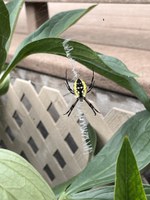Dakota Gardener: A garden visitor
(Click an image below to view a high-resolution image that can be downloaded)
By Carrie Knutson, Horticulture agent
NDSU Extension – Grand Forks County
One day last month, my kids ran into the house very alarmed. There was a large spider and web in one of my peony plants. I will admit I didn’t move too fast. My kid’s judgement on the size of spiders is questionable. However, I was surprised to find a large and rather intimidating spider.
A quick search and an email to our NDSU Extension entomologist, Janet Knodel, confirmed we had a black and yellow garden spider.
The black and yellow garden spider has many common names but is easily recognizable. The females have a distinct pattern on the abdomen. The males are smaller than females.
Their web has an amazing feature: a zig-zag zipper section in the middle. The correct name for the structure is stabilimentum. There is some debate as to whether the structure is for stability, or to attract insects and prevent birds from flying into the web.
Black and yellow garden spiders are beneficial garden insects. We tend to think of bees, butterflies and lady beetles as beneficial insects. Beneficial insects can provide a service, like pollination or they can reduce the number of insects.
The black and yellow garden spider will eat dragon flies, damsel flies, wasps and even bees. They will also feed on flies, beetles and grasshoppers. We have lots of flies and grasshoppers this year. I have seen a few flies in the web but no grasshoppers yet.
Black and yellow garden spiders are not aggressive and will usually leave you alone if you leave it alone. We are careful to observe the spider and web but don’t get too close. The alarm does sound when the spider isn’t in its normal spot so we can be on the lookout.
If you do end up with a close encounter with a black and yellow garden spider, don’t worry. Their bite isn’t poisonous.
After our discovery, I spent the next several weeks defending the spider to my kids and relatives. Yes, it was in our yard, but that is its place to live so we will leave it alone. If it were to get into the house, I would catch it and put it back outside.
One fact I did not readily share with my kids or family, is the number of eggs a female can produce. According to Mississippi State University Extension, females can lay up to four egg sacs a year. Each egg sac can contain up to 1,000 eggs.
The young spiders will hatch but remain in the egg sac and over-winter to emerge in the spring. Fortunately, or unfortunately (depending on how you look at it) the young spiders have a lower survival rate, 50% or less. We will see how many spiders we can spot next year! Happy gardening!
NDSU Agriculture Communication – Sept. 5, 2023
Source: Carrie Knutson, 701-780-8229, carrie.knutson@ndsu.edu
Editor: Kelli Anderson, 701-231-6136, kelli.c.anderson@ndsu.edu




